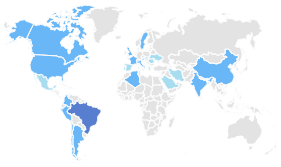Revisão e Implementação de Soluções Analíticas para a Determinação da Pressão em Poços de Petróleo
Resumo
A Análise de Testes de Poços é um ramo da Engenharia de Reservatórios no qual
empregamos dados de pressão de poço a partir de testes de produção/injeção de fluido em conjunto com modelos físico-matemáticos para caracterizar o sistema poço-reservatório, usando problemas inversos. Nessas situações, aplicamos amplamente soluções analíticas e semianalíticas do modelo físico-matemático que descreve o fluxo. Nesse contexto, o objetivo do presente estudo é 1) realizar uma revisão bibliográfica sobre algumas das soluções analíticas clássicas para determinação da pressão no poço produtor e 2) implementar os códigos numéricos para a criação de uma biblioteca computacional, proporcionando as soluções analíticas voltadas para a determinação da pressão em poços produtores de petróleo. Os sistemas poço-reservatório estudados possuem um poço vertical e levam em consideração os efeitos de condições de contorno, a estocagem na coluna de produção do poço, dano à formação, períodos de fluxo e estática, bem como a presença de fraturas naturais. Obtivemos as soluções analíticas usando a transformada de Laplace e uma inversão numérica, utilizando o algoritmo Stehfest, para calcular a variação de pressão ao longo do tempo.
Palavras-chave: Soluções Analíticas, Transformada de Laplace Inversa, Tranformada de Laplace, Algoritmo de Stehfest, Análise de Teste de Poço.
===================================================================
Well Testing Analysis is a branch of Reservoir Engineering, in which we
employ well pressure data from production tests/fluid injection in conjunction with physical-mathematical models to characterize the well-reservoir system, using inverse problems. In these situations, we widely used analytical and semi-analytical solutions of the physical-mathematical model that describes the flow. In this context, the objective of this work is to 1) carry out a bibliographic review on some of the classic analytical solutions for determining the pressure in the producing well and 2) implement the numerical codes for the creation of a computational library, providing the analytical solutions aimed at determining pressure in oil-producing wells. The well-reservoir systems with a vertical well take into account the boundary effects, wellbore storage, formation damage, drawdown and buildup test analysis, and the presence of natural fractures. We obtain the analytical solutions using the Laplace transform and a numerical inversion, using the Stehfest algorithm, to calculate the pressure variation in the time domain.
Key words: Analytical Solutions, Inverve Laplace Transform, Laplace Transform, Stehfest Algorithm, Well Testing Analysis.
Texto completo:
PDFReferências
Bourdet, D. (2002). Well Test Analysis: the Use
of Advanced Interpretation Models. Handbook of
Petroleum Exploration and Production 3. Elsevier,
Amsterdam.
Adameka, V.; Vales, F.; Cerv, J. (2016). Numerical
Laplace inversion in problems of elastodynamics:
Comparison of four algorithms. Advances in Engineering
Software, 113 , 1–10.
Awais, M. (2015). Applications of the numerical
inversion of the Laplace transform to unsteady problems
of the third grade fluid. Applied Mathematics
and Computation, 250 , 228–234.
Bourdet, D.; Ayuob, J. A.; Pirard, Y. M. (1989).
Use of pressure derivative in well-test interpretation.
SPE Formation Evaluation, 19, 293–302.
Campos, R. G.; Huet, A. (2018). Numerical inversion
of the Laplace transform and its application
to fractional diffusion. Applied Mathematics and
Computation, 327 , 70–234.
Chaudhry, A. U. (2004). Oil Well Testing Handbook.
Gulf Professional Publishing, Burlington.
Chen, C. C.; Raghavan, R. (1996). An approach
to handle discontinuities by the Stehfest algorithm.
SPE Journal, 363.
Chen, S.; Liu, F.; Turner, I.; Hu, X. (2018). Numerical
inversion of the fractional derivative index
and surface thermal flux for an anomalous heat conduction
model in a multi-layer medium. Applied
Mathematical Modelling, 59, 514–526.
DOI: http://dx.doi.org/10.17648/calibre.v5.1477
Apontamentos
- Não há apontamentos.
Direitos autorais 2020 Igor Caetano Cariello, Paulo de Tarço Honório Junior, Grazione de Souza, Helio Pedro Amaral Souto
Indexadores, Diretórios, Bases de Dados e Registros (Abstracted and Indexed in):

CALIBRE - Revista Brasiliense de Engenharia e Física Aplicada
ISSN Eletrônico: 2526-4192































